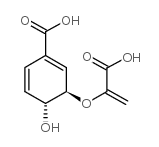Roles of trpE2, entC and entD in salicylic acid biosynthesis in Mycobacterium smegmatis.
Nivedita Nagachar, Colin Ratledge
Index: FEMS Microbiol. Lett. 308(2) , 159-65, (2010)
Full Text: HTML
Abstract
Mycobacterium smegmatis acquires extracellular iron using exochelin, mycobactin and carboxymycobactin. The latter two siderophores are synthesized from salicylic acid, which, in turn, is derived from chorismic acid in the shikimic acid pathway. To understand the conversion mechanism of chorismic acid to salicylic acid in M. smegmatis, knockout mutants of the putative key genes, trpE2, entC and entD, were created by targeted mutagenesis. By enzymatic assays with the cell-free extracts of the various knockout mutants, we have shown that TrpE2 converts chorismic acid into isochorismic acid and is thus an isochorismate synthase. The gene products of both entC and entD are involved in the conversion of isochorismic acid into salicylic acid, and hence correspond to salicylate synthase.
Related Compounds
| Structure | Name/CAS No. | Molecular Formula | Articles |
|---|---|---|---|
 |
Chorismic acid, from Enterobacter aerogenes
CAS:617-12-9 |
C10H10O6 |
|
Complex Formation between Two Biosynthetic Enzymes Modifies ...
2015-07-17 [J. Biol. Chem. 290 , 18187-98, (2015)] |
|
Biosynthesis of salicylic acid in plants.
2009-10-01 [Plant Signal Behav. 4(6) , 493-6, (2009)] |
|
AhpC is required for optimal production of enterobactin by E...
2012-12-01 [J. Bacteriol. 194(24) , 6748-57, (2012)] |
|
Accumulation of isochorismate-derived 2,3-dihydroxybenzoic 3...
2010-08-13 [J. Biol. Chem. 285(33) , 25654-65, (2010)] |
|
Biosynthesis of the immunosuppressants FK506, FK520, and rap...
2011-03-22 [Proc. Natl. Acad. Sci. U. S. A. 108(12) , 4776-81, (2011)] |